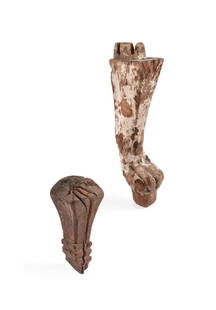
Egyptian Painted Gesso Crook & Flail Handles (pr)
Similar Sale History
View More Items in Chairs

Related Chairs
More Items in Chairs
View MoreRecommended Furniture
View More







Item Details
Description
Egypt, Late Dynastic to Ptolemaic Period, ca. 664 to 30 BCE. A rare set of funerary offerings that are carved from hardwood, covered in white gesso, and shaped to resemble the highly symbolic crook-headed scepter (known as a heka) and the multi-tailed flagellum or flail (known as a nekhakha) held by the god Osiris. The crook handle features a white body decorated with alternating black and red rings until terminating in a yellow-painted head with a slanted groove that would taper to form the crook body. The flagellum handle features red, black, and yellow rings along its white body until tapering to form the gently carinated flail neck with a conical dowel meant to hold a flail head. Each pole body has a narrow dowel protruding from the base that suggests they were to be inserted into a larger wooden sculptural funerary offering like a coffin or sarcophagus. Size of largest (crook handle): 20.6" L x 1.2" W (52.3 cm x 3 cm)
The crook and flail are two of the most iconic images from ancient Egypt and are synonymous with Osiris, the god of the underworld; however, their origins likely do not begin with Osiris. According to author Katharine Stoddert Gilbert, "Osiris is believed to have acquired them from Andjeti, the local god of a town in the Delta named Djedu, who was represented in human form with two feathers on his head and holding the crook and flail in his hands. At a very early date in Egyptian history Osiris absorbed Andjeti and adopted his insignia. Osiris, however, was regarded not only as a god but also as a deified deceased king and consequently his insignia, particularly the crook and flail, were treated as symbols of royalty." (Gilbert, Katharine Stoddart, Joan K. Holt, and Sara Hudson. "Treasures of Tutankhamun." The Metropolitan Museum of Art exhibition catalogue, Ballantine Books, New York, 1976, p. 106)
Provenance: private J.H. collection, Beaverton, Oregon, USA, acquired in March 2015; ex-private Montrose, California, USA collection; ex-private Los Angeles, California, USA collection
All items legal to buy/sell under U.S. Statute covering cultural patrimony Code 2600, CHAPTER 14, and are guaranteed to be as described or your money back.
A Certificate of Authenticity will accompany all winning bids.
We ship worldwide to most countries and handle all shipping in-house for your convenience.
#153894
The crook and flail are two of the most iconic images from ancient Egypt and are synonymous with Osiris, the god of the underworld; however, their origins likely do not begin with Osiris. According to author Katharine Stoddert Gilbert, "Osiris is believed to have acquired them from Andjeti, the local god of a town in the Delta named Djedu, who was represented in human form with two feathers on his head and holding the crook and flail in his hands. At a very early date in Egyptian history Osiris absorbed Andjeti and adopted his insignia. Osiris, however, was regarded not only as a god but also as a deified deceased king and consequently his insignia, particularly the crook and flail, were treated as symbols of royalty." (Gilbert, Katharine Stoddart, Joan K. Holt, and Sara Hudson. "Treasures of Tutankhamun." The Metropolitan Museum of Art exhibition catalogue, Ballantine Books, New York, 1976, p. 106)
Provenance: private J.H. collection, Beaverton, Oregon, USA, acquired in March 2015; ex-private Montrose, California, USA collection; ex-private Los Angeles, California, USA collection
All items legal to buy/sell under U.S. Statute covering cultural patrimony Code 2600, CHAPTER 14, and are guaranteed to be as described or your money back.
A Certificate of Authenticity will accompany all winning bids.
We ship worldwide to most countries and handle all shipping in-house for your convenience.
#153894
Condition
Original lower bodies, crook head, and flail head are missing as shown. Loss to dowel atop crook handle as shown. Each handle has chipping and minor fading to original pigmentation, light abrasions and nicks to bodies and painted gesso, and desiccation to wood commensurate with age. Light earthen deposits and wonderful remains of original painted gesso throughout.
Buyer's Premium
- 24.5%
Egyptian Painted Gesso Crook & Flail Handles (pr)
Estimate $1,800 - $2,500
Get approved to bid.
Shipping & Pickup Options
Item located in Louisville, CO, usSee Policy for Shipping
Payment

TOP














































































